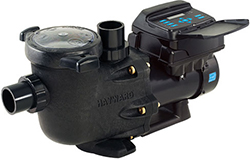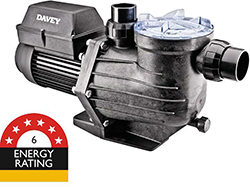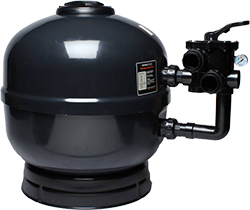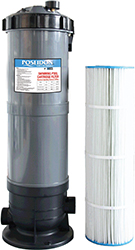Are you thinking about taking the plunge and buying a pool? Or are you flooded with pool troubles and need to replace an old or damaged pump unit?
Pools and spas are a cool investment, but the necessary expense of running the pool pump can drown households in at least $800 to $1,200 annually. In fact, the retail price of a swimming pool pump is said to make up only 20% of the total expenses you’ll spend on an average pump. The remaining 80% relates to the long-term energy costs involved in actually using the pump. That’s why it’s so important to make sure you know what you’re diving into.
How does a pool pump work?

The pump plays a major part in how a pool works, especially when it comes to keeping it clean. The pump pulls water from either the pool drain or pool deck skimmer, or sometimes both, before sending it through a filter. If a heater or chlorinator has been fitted, the unit will also pump the water through these attachments prior to returning the water back into the pool.
With the exception of variable speed pool pumps, most pool pumps are usually constructed with an induction-style electric motor. Alternatively, variable speed pumps are designed with permanent electric magnet motors which allow them to operate at any number of speeds allowed by the design.
- Single Speed Pumps: single speed pumps can only work at one speed.
- Dual speed: a dual speed pump can function at two different speeds.
- Multiple Speed: multiple speed pumps can operate at several fixed speeds.
- Variable Speed: a variable speed drive controller connects to the pump, which allows you to program different speed and flow settings in order to tailor the pump to suit a range of uses.
How much energy does a pool pump use?
It’s no surprise that Australia has won gold with the highest number of pool owners per capita in the world, with 1.2 million household swimming pools apparently splashed out across the country. But the humble pump unit in your pool or spa is claimed to be responsible for approximately 16 percent of your energy bills, making it the largest single user of residential electricity in Australia. If you live in Victoria, the figure is said to almost double and can contribute between 20 and 30 percent towards your energy bill.
Different factors can affect how much energy a pool pump uses. Some of these include:
- Size of pool
- Type of filter
- Type and number of pool fittings
- Whether a heater, chlorinator or other type of attachment is fitted
- How rigorously the pump operates on a regular basis (including how frequently the pump backwashes in order to clean filter)
- Pump efficiency.
How can I find an energy efficient pool pump?

Before you reach for your wallet, remember to research a variety of pumps and seek several quotes before making a decision. Energy rating calculators are also handy when considering aspects other than sale price. These online tools can help you take into account useful long-term factors and are readily available through government portals or brand websites. For example, you can look into how much energy a pool is likely to use or what it might cost to operate a particular unit.
How to pick the right pump size
When it comes to pool pumps, bigger isn’t always better. It’s all about using the right pump for the right job. Using a pump at a higher flow rate than what it was originally designed for can lead to a flood of problems. Similarly, the size of a pool isn’t always an indication of whether you need a small or large filtration pool pump.
While it may be tempting to buy a small pump in order to save a few bucks, the low wattage might not be suitable for your pool or spa. This can in-turn impact how well the pump performs, increase the risk of damage, and create a fast lane to a dirty pool. Finding the right size pump might also help you avoid wasting hundreds of dollars per year on ongoing energy costs, which would otherwise be much cheaper if the correct sized pump was used.
Check how many kilowatts your existing pump is rated for
To help you figure out how much energy your pump is using, the most common sized pumps are:
- Approximately 0.75kWh usually indicates a 1 horsepower pump
- Approximately 1.10kWh usually indicates 1.5 horsepower pump
- Approximately 0.5kWh usually indicates a 3/4 horsepower pump
- Approximately 1.7kWh usually indicates a 2 horsepower pump.
Check the diameter of your filter
There is no such thing as a one-size fits-all pump. Different types of filters require a compatible sized pump to function effectively, otherwise you risk causing serious damage to your pool. Two common types of filters are sand filters and cartridge filters.
Sand filters

If you have a sand filter, a pump that is too large can prevent proper filtration. It apparently causes the water to cross the sand too quickly, creating channels in the sand bed which ultimately limits water from filtering sand when it passes down the channels. Alternatively, a pump that is too small might restrict the filter’s functions. The size might restrict the sand from lifting, which usually needs to occur in order for the pump to clean the sand and keep the filter operating. This ends up causing a blockage and puts the filtration system under too much pressure.
For sand filters, some of the common sizes are:
- 20 inches
- 25 inches
- 28 inches
- 31 inches
Cartridge filters

An oversized pump can put too much pressure on a cartridge filter, eventually putting enough strain to cause both the tank and filter to fail prematurely. If you have a saltwater pool, an undersized pump can stop producing chlorine if the filter is deprived of water.
For cartridge filters, you can typically work out the diameter by looking at the label on the filter. The common sizes are:
- 50 square foot
- 100 square foot
- 150 square foot
- 200 square foot
When should I replace my pool pump?
Pool pumps don’t last forever and need to be replaced every once in a while. There are a few clear signs you should be aware of to ensure your pool water can continue sparkling.
Dirty and murky pool water
A change in pool water quality can be a sign of a faulty pump, filter or chlorinator. But make sure to test the water with a pool testing kit beforehand. Your pool might just need a top-up of chlorine or another chemical to reset the balance of the pool water.
Old age
As a general rule, you should invest in maintaining the health of your pool pump. This can be done by lubricating bearings, fixing leaks, and ensuring the pool is serviced each year. But if your pool pump is passing a decade old, it’s probably time to let go. The lifespan of pool pumps also depend on factors like pool size, and whether the pump is an above-ground pool pump or an in-ground pool pump.
Damage
Cracks or other signs of wear and tear must be repaired to ensure your pool continues operating efficiently. But if a significant amount of the interior needs fixing, the cost of replacement might be more affordable than paying for regular maintenance.

Share this article